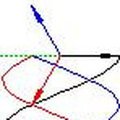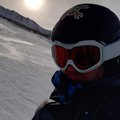-
Hack Chat Transcript, Part 2
06/08/2022 at 20:10 • 0 comments![]() @Nick Rehm couldn't you just use some form of current sensing? You know the current pretty well and also the shape of the conductor
@Nick Rehm couldn't you just use some form of current sensing? You know the current pretty well and also the shape of the conductor![]() @Joe Stavitsky I actually don't know of too many opensource software options for rotor design. Most stuff I've worked with was proprietary/in-house. Simple momentum analysis can get you a surprisingly long way though
@Joe Stavitsky I actually don't know of too many opensource software options for rotor design. Most stuff I've worked with was proprietary/in-house. Simple momentum analysis can get you a surprisingly long way though![]() @pascal.fust Yup. Homogenous, no fusing lines, 100% fill factor. Heard something about increase of fracture toughness by graphene or nanotubes.
@pascal.fust Yup. Homogenous, no fusing lines, 100% fill factor. Heard something about increase of fracture toughness by graphene or nanotubes.![]() @Nick Rehm So you have used commercial software? Which did you like?
@Nick Rehm So you have used commercial software? Which did you like?![]() One option for "3D Printed" rotors I've been thinking about is just using the 3d print as a mold for a cast epoxy/glass final product
One option for "3D Printed" rotors I've been thinking about is just using the 3d print as a mold for a cast epoxy/glass final product![]() I mean, who really cares about durability of 3d prints? At that price, the fragility is kind of the point. As long as it lasts the entire flight, and collisions will ground you no matter what your rotors are made of
I mean, who really cares about durability of 3d prints? At that price, the fragility is kind of the point. As long as it lasts the entire flight, and collisions will ground you no matter what your rotors are made of![]() @Nick Rehm also, do you recommend any kind of "wind tunnel arrangement" to test propellers, to control for temperature, humidity, etc?
@Nick Rehm also, do you recommend any kind of "wind tunnel arrangement" to test propellers, to control for temperature, humidity, etc?![]() Casting forfeits the advantage of being able to place infill where it's needed for strength but otherwise conserve lightness, which I think is a big deal in 3DP. Just need that second extruder with a carbon fiber strand that it can smush into the still-warm top layer before extruding more plastic over it ;)
Casting forfeits the advantage of being able to place infill where it's needed for strength but otherwise conserve lightness, which I think is a big deal in 3DP. Just need that second extruder with a carbon fiber strand that it can smush into the still-warm top layer before extruding more plastic over it ;)![]() @Thomas Shaddack I mean, we are talking about tip speeds of 200-300km/h or more, depending on the design
@Thomas Shaddack I mean, we are talking about tip speeds of 200-300km/h or more, depending on the design![]() If it's big enough, could even print out a channel to slot in a carbon spar after the fact. I've done that with tiny LW-PLA blades with a 2mm carbon spar
If it's big enough, could even print out a channel to slot in a carbon spar after the fact. I've done that with tiny LW-PLA blades with a 2mm carbon spar![]() Yea I guess the big question is how big of a rotor are we talking?
Yea I guess the big question is how big of a rotor are we talking?![]() Yeah, for land-based stuff I print 1/4-20-threaded hollows in a lot of my larger parts and add some all-thread when it's done printing. Something like that for CF tube would make a lot of sense.
Yeah, for land-based stuff I print 1/4-20-threaded hollows in a lot of my larger parts and add some all-thread when it's done printing. Something like that for CF tube would make a lot of sense.![]() I think that size does not really matter as smaller size implies higher rotation speed, resulting in higher forces
I think that size does not really matter as smaller size implies higher rotation speed, resulting in higher forces![]() @Joe Stavitsky re: wind tunnels: just be sure to keep your reynolds number constant
@Joe Stavitsky re: wind tunnels: just be sure to keep your reynolds number constant![]() Fc = mv^2/r
Fc = mv^2/r![]() @Nick Rehm cool makes total sense
@Nick Rehm cool makes total sense![]() And, rotational force is only part of the game.... don't talk about about torsion
And, rotational force is only part of the game.... don't talk about about torsion![]() Fun fact: only reason heli blades don't break despite being so flimsy is that the centripetal force literally pulls them tight
Fun fact: only reason heli blades don't break despite being so flimsy is that the centripetal force literally pulls them tight![]() @Nick Rehm We heart Physics =P
@Nick Rehm We heart Physics =P![]() makes sense, also why they wobble so much as they go around their circle
makes sense, also why they wobble so much as they go around their circle![]()
https://youtu.be/3-Kr3I_nNCs?t=40
![]() lol
lol![]() oh now I'm gonna have the Airwolf theme in my head
oh now I'm gonna have the Airwolf theme in my head![]() Underrated movie
Underrated movie![]() Did I miss any questions/topics? Sorry tried my best to keep up. I can hang around for a few more minutes
Did I miss any questions/topics? Sorry tried my best to keep up. I can hang around for a few more minutes![]() Are you open to followup contact?
Are you open to followup contact?![]() Wobble is maybe not a problem, but twisting might destroy the nicest pitch
Wobble is maybe not a problem, but twisting might destroy the nicest pitch![]() @Nick Rehm yeah I'd be really stoked if you had time to look at my props once I get started
@Nick Rehm yeah I'd be really stoked if you had time to look at my props once I get started![]() Sure, ya'll can email me at nicholasrehmyt@gmail.com. Very happy to nerd out over projects or answer and deep questions about drones/helis/autonomy
Sure, ya'll can email me at nicholasrehmyt@gmail.com. Very happy to nerd out over projects or answer and deep questions about drones/helis/autonomy![]() @pascal.fust Aeroelasticity for the rescue?
@pascal.fust Aeroelasticity for the rescue?![]() Or I guess direct message me here; I don't check hackaday messages as often tho
Or I guess direct message me here; I don't check hackaday messages as often tho![]() hmmm... if well predicted, it can work out
hmmm... if well predicted, it can work out![]() Keep the chord-wise structural center of your blade ahead of the lift center and most twisting problems will go away
Keep the chord-wise structural center of your blade ahead of the lift center and most twisting problems will go away![]() Nick Do you know anyone in the public sector dealing with business or contracts?
Nick Do you know anyone in the public sector dealing with business or contracts?![]() @Nick Rehm Awesome, tyvm. If you have time I'm sure you'd be welcome at Physics Forums as well, I hang out there a lot and I'm positive they don't have any aerospace people whatsoever
@Nick Rehm Awesome, tyvm. If you have time I'm sure you'd be welcome at Physics Forums as well, I hang out there a lot and I'm positive they don't have any aerospace people whatsoever![]() good point
good point![]() I'd need to dig out my leishman textbook for a refresher before giving better rotor design advice lol
I'd need to dig out my leishman textbook for a refresher before giving better rotor design advice lol![]() And look at that -- already 1:00! That was fast - I didn't even get to ask about Ingenuity! I want to thank Nick for his time today, and everyone for the great discussion.
And look at that -- already 1:00! That was fast - I didn't even get to ask about Ingenuity! I want to thank Nick for his time today, and everyone for the great discussion.![]() Does that suggest that, when aero quads go inverted and spin their props backwards, the blades themselves are inherently unstable?
Does that suggest that, when aero quads go inverted and spin their props backwards, the blades themselves are inherently unstable?![]() Thanks Dan, I'll be here a few more minutes :)
Thanks Dan, I'll be here a few more minutes :)Thank you @Dan Maloney and @Nick Rehm :-)
![]() Yes, thank you all! Some of us will continue to dribble out ideas indefinitely unless booted out ;)
Yes, thank you all! Some of us will continue to dribble out ideas indefinitely unless booted out ;)![]() @Nick Rehm I terms of VTOL transition UAVs, which approach would you consider most efficient, the blended wing, or fixed wing?
@Nick Rehm I terms of VTOL transition UAVs, which approach would you consider most efficient, the blended wing, or fixed wing?![]() Do you recommend any "seminal texts" on aerospace engineering?
Do you recommend any "seminal texts" on aerospace engineering?![]() Don't feel booted, always open here for discussion. Just need to let Nick get back to work if he has to.
Don't feel booted, always open here for discussion. Just need to let Nick get back to work if he has to.![]() reverse props: yes but miniquad props are so darn stiff that the torsional frequency is too high to do anything interesting (explosive)
reverse props: yes but miniquad props are so darn stiff that the torsional frequency is too high to do anything interesting (explosive)![]() Anderson's intro to aerospace book is a good read
Anderson's intro to aerospace book is a good read![]() Thanks
Thanks![]() VTOLS: really depends on the integration of the vertical lift propulsion vs. forward flight propulsion. Think: how much is dead weight in forward flight, how much drag does a lifting motor induce in forward flight, can you use a lifting motor as a forward flight motor?
VTOLS: really depends on the integration of the vertical lift propulsion vs. forward flight propulsion. Think: how much is dead weight in forward flight, how much drag does a lifting motor induce in forward flight, can you use a lifting motor as a forward flight motor?![]() Sure. Thanks for your advice and sharing your knowledge and opinion
Sure. Thanks for your advice and sharing your knowledge and opinion![]() Alright y'all, thanks for having me. Don't hesitate to DM or email. I'm not an expert by any means of the word, but I am quite a big nerd who's always excited to help others out :)
Alright y'all, thanks for having me. Don't hesitate to DM or email. I'm not an expert by any means of the word, but I am quite a big nerd who's always excited to help others out :)![]() Thanks Nick! And thanks all for the engagement. Transcript to follow
Thanks Nick! And thanks all for the engagement. Transcript to follow -
Hack Chat Transcript, Part 1
06/08/2022 at 20:10 • 0 comments![]() Welcome to the Hack Chat everyone, let's get started. I'm Dan, I'll be modding today along with Dusan (I think) as we welcome Nick Rehm to talk about Aerial Robotics.
Welcome to the Hack Chat everyone, let's get started. I'm Dan, I'll be modding today along with Dusan (I think) as we welcome Nick Rehm to talk about Aerial Robotics.![]() Hi Dan!
Hi Dan!![]() Hey everybody, can you hear me?
Hey everybody, can you hear me?![]() Welcome everyone!
Welcome everyone!![]() No but we can see you :)
No but we can see you :)Hi @Dan Maloney and @Nick Rehm :-)
![]() Hi Nick, thanks for coming on today. can you start us off with a little about yourself?
Hi Nick, thanks for coming on today. can you start us off with a little about yourself?![]() nothing to hear, but I can read you
nothing to hear, but I can read you![]() +1
+1![]() Sure Dan
Sure Dan![]() I've been into radio control aircraft for about 14 years, so it was really fun to see the drone revolution happen in front of my eyes growing up. Graduated from University of Maryland in 2019 with BS in aero engineering, then went on to masters of aero/rotorcraft with a focus in aerial robotics/dynamics/control
I've been into radio control aircraft for about 14 years, so it was really fun to see the drone revolution happen in front of my eyes growing up. Graduated from University of Maryland in 2019 with BS in aero engineering, then went on to masters of aero/rotorcraft with a focus in aerial robotics/dynamics/control![]() My favorite era of aerial robots / done was the multi-wii flight controller days where I had to convince my mom that I needed to tear apart the wii controller to build a drone
My favorite era of aerial robots / done was the multi-wii flight controller days where I had to convince my mom that I needed to tear apart the wii controller to build a drone![]() Heh, I screwed around with that briefly
Heh, I screwed around with that briefly![]() Did she buy it?
Did she buy it?![]() It finally clicked for her when she saw a wooden tricopter floating around the front yard haha
It finally clicked for her when she saw a wooden tricopter floating around the front yard haha![]() Lulz
Lulz![]() Better to ask forgiveness than seek permission, right?
Better to ask forgiveness than seek permission, right?![]() was the wii controller used to control the drone, or in the drone out of interest
was the wii controller used to control the drone, or in the drone out of interest![]() With an accompanying triumphant scream of "IT'S ALIIIiiiiiive!", I presume?
With an accompanying triumphant scream of "IT'S ALIIIiiiiiive!", I presume?![]() I think my parents loved the idea of RC because it kept me both in my room and away from video games
I think my parents loved the idea of RC because it kept me both in my room and away from video games![]() @Nick Rehm Was your masters at University of Maryland? (College Park years were some of the best)
@Nick Rehm Was your masters at University of Maryland? (College Park years were some of the best)![]() We used the IMU from the wii motion plus back before IMUs were cheap as heck
We used the IMU from the wii motion plus back before IMUs were cheap as heck![]() cool :)
cool :)![]() nice hack
nice hack![]() @Nick Rehm do you mind saying where you work?
@Nick Rehm do you mind saying where you work?![]() Ahh yes, masters from maryland as well--I went straight from BS to my MS program because I was already well acquainted with the rotorcraft center team
Ahh yes, masters from maryland as well--I went straight from BS to my MS program because I was already well acquainted with the rotorcraft center team![]() I'm at JHU APL working as an aero engineer
I'm at JHU APL working as an aero engineer![]() I'll leave it at that, but obviously there is some overlap in hobby/job skills
I'll leave it at that, but obviously there is some overlap in hobby/job skills![]() @Nick Rehm awesome
@Nick Rehm awesome![]() Could you tell us which kind of projects you have worked on
Could you tell us which kind of projects you have worked on![]() ?
?![]() @Nick Rehm What do you think about the optimization of aircrafts for VTOL/fixed wing UAV ?
@Nick Rehm What do you think about the optimization of aircrafts for VTOL/fixed wing UAV ?![]() Sure, one project I have out there is an open-source flight controller which I use on every single flying thing I make: https://github.com/nickrehm/dRehmFlight
Sure, one project I have out there is an open-source flight controller which I use on every single flying thing I make: https://github.com/nickrehm/dRehmFlight![]() good stuff
good stuff![]() It is meant as a teaching tool for people who aren't too familiar with software dev
It is meant as a teaching tool for people who aren't too familiar with software devHey Nick, what is in your opinion the next big challenge in the domain of small autonomous flying robots?
![]() @pascal.fust I think optimization is extremely hard until the system constraints are defined really really well. For example, "we need a vtol that can fly for a long time".... Can that vtol transition and fly on a wing? Are there loitering constraints? Funny enough most problems not involving the need for a loitering camera can be solved with a regular fixed wing
@pascal.fust I think optimization is extremely hard until the system constraints are defined really really well. For example, "we need a vtol that can fly for a long time".... Can that vtol transition and fly on a wing? Are there loitering constraints? Funny enough most problems not involving the need for a loitering camera can be solved with a regular fixed wing![]() @Nick Rehm I mean, in that formulation if you can circle small enough you can call it "loitering" I think?
@Nick Rehm I mean, in that formulation if you can circle small enough you can call it "loitering" I think?![]() @Yohan Hadji I think the big challenge always has been and will continue to be onboard state estimation. It's getting better with better sensors and lighter computing, but still not at the level of motion cap facilities
@Yohan Hadji I think the big challenge always has been and will continue to be onboard state estimation. It's getting better with better sensors and lighter computing, but still not at the level of motion cap facilities![]() I agree. But, I can also observe that most VTOL aircrafts out there still don't benefit of the fact, that takeoff/landing low speed lift capabilities are not required
I agree. But, I can also observe that most VTOL aircrafts out there still don't benefit of the fact, that takeoff/landing low speed lift capabilities are not required![]() @Nick Rehm sorry, "state estimation"?
@Nick Rehm sorry, "state estimation"?![]() VTOL solely for takeoff/landing is definitely desirable when runway space is limited
VTOL solely for takeoff/landing is definitely desirable when runway space is limited![]() @Joe Stavitsky state estimation meaning measurement of a drone's orientation/position/motion in space relative to the world
@Joe Stavitsky state estimation meaning measurement of a drone's orientation/position/motion in space relative to the world![]() @Nick Rehm interesting. It never struck me as a major problem but googling now it seems I was very wrong.
@Nick Rehm interesting. It never struck me as a major problem but googling now it seems I was very wrong.![]() Do you think there is still room for small companies in the UAV space?
Do you think there is still room for small companies in the UAV space?![]() I would say state estimation is 95% of the problem of deploying any sort of autonomy in a real-world environment. You may have seen those awesome autonomous drone aerobatics demos--looks closely. All of the state estimation is happening via motion capture cameras
I would say state estimation is 95% of the problem of deploying any sort of autonomy in a real-world environment. You may have seen those awesome autonomous drone aerobatics demos--looks closely. All of the state estimation is happening via motion capture cameras![]() My point was, that in case the operation requires VTOL transitioning capabilities, aircraft design should take advantage of it, but rarely does
My point was, that in case the operation requires VTOL transitioning capabilities, aircraft design should take advantage of it, but rarely does![]() Have you looked into controlling multiple drones, for things like lighting displays, that looks like it'd be very complex, but looks v. impressive
Have you looked into controlling multiple drones, for things like lighting displays, that looks like it'd be very complex, but looks v. impressive![]() ....i.e., why should an aircraft be able to fly at low air speeds when it has VTOL units?
....i.e., why should an aircraft be able to fly at low air speeds when it has VTOL units?![]() @pascal.fust ahhh, very true.
@pascal.fust ahhh, very true.![]() @Nick Rehm One thing that fascinated me was the choreographed big networks of tiny drones. If you've seen those, would you say the state estimation problem is more or less difficult for them?
@Nick Rehm One thing that fascinated me was the choreographed big networks of tiny drones. If you've seen those, would you say the state estimation problem is more or less difficult for them?![]() @anfractuosity definitely looked into it, but gets expensive fast between a ground station, distributed telemetry equipment, and then all of the vehicles lol
@anfractuosity definitely looked into it, but gets expensive fast between a ground station, distributed telemetry equipment, and then all of the vehicles lol![]() Why hasn't a partially buoyant either He or H2 assisted drone become a useful means to extend flight time with the reduced power requirements?
Why hasn't a partially buoyant either He or H2 assisted drone become a useful means to extend flight time with the reduced power requirements?![]() To my knowledge drone shows like that are using a combination of RTK-GPS which is a really good state estimate on its own, as well as ground-based sensors to further correct GPS drift
To my knowledge drone shows like that are using a combination of RTK-GPS which is a really good state estimate on its own, as well as ground-based sensors to further correct GPS drift![]() I could be wrong
I could be wrong![]() @kjansky1 most probably because you would need a good volume which results in extended drag
@kjansky1 most probably because you would need a good volume which results in extended drag![]() @Joe Stavitsky Any measurements that help you know what is happening. Velocity, acceleration, rotation, rotation rate, vibrational FFTs. Voltages, currents, battery and fuel capacity, temperature, density, clear air turbulence. Lots of sensors available, and thousands more in development, in thousands of labs. But a mess, expensive and everyone for themselves.
@Joe Stavitsky Any measurements that help you know what is happening. Velocity, acceleration, rotation, rotation rate, vibrational FFTs. Voltages, currents, battery and fuel capacity, temperature, density, clear air turbulence. Lots of sensors available, and thousands more in development, in thousands of labs. But a mess, expensive and everyone for themselves.@kjansky1 There are stationary airships proposed for months and years long "low orbit" satellites.
![]() @kjansky1 wind :)
@kjansky1 wind :)![]() @Nick Rehm not sure if we're talking about the same thing, I meant the really tiny ones. Let me see if I can find video.
@Nick Rehm not sure if we're talking about the same thing, I meant the really tiny ones. Let me see if I can find video.![]() Above 100,000 feet. But if you can make big ones, then tiny ones are possible too. You have to decide what things you like making, and who you want to work with.
Above 100,000 feet. But if you can make big ones, then tiny ones are possible too. You have to decide what things you like making, and who you want to work with.![]() @Nick Rehm Which system of aircraft control (autopilot,etc.) would you see as most promising for future developments?
@Nick Rehm Which system of aircraft control (autopilot,etc.) would you see as most promising for future developments?![]() Not exactly it, but close enough
Not exactly it, but close enough![]()
https://www.youtube.com/watch?v=hj_SBSpK5qg
![]() @pascal.fust I'm not sure I follow, could you elaborate? Like what general components need more work, or what existing packages show promise?
@pascal.fust I'm not sure I follow, could you elaborate? Like what general components need more work, or what existing packages show promise?![]() If only partially buoyant and streamlined drag would be insignificant if only low speeds but increased loitering time would be the requirement. Wind is not a factor because the drone is still powered. Goodyear is fully buoyant and it has no problem in maneuvering.
If only partially buoyant and streamlined drag would be insignificant if only low speeds but increased loitering time would be the requirement. Wind is not a factor because the drone is still powered. Goodyear is fully buoyant and it has no problem in maneuvering.![]() @Joe Stavitsky Something like that is probably doing very simple position estimation using an optical flow camera
@Joe Stavitsky Something like that is probably doing very simple position estimation using an optical flow camera![]() looking at open source solutions, would you think that ardupilot, pixhawk, etc. are most promising for future developments?
looking at open source solutions, would you think that ardupilot, pixhawk, etc. are most promising for future developments?![]() @Nick Rehm I've seen other projects where they are much more carefully choreographed, like in a square grid that undulates vertically
@Nick Rehm I've seen other projects where they are much more carefully choreographed, like in a square grid that undulates vertically![]() Or do you see more elaborated systems at the horizon?
Or do you see more elaborated systems at the horizon?![]() @Joe Stavitsky Look for the motion capture cameras!
@Joe Stavitsky Look for the motion capture cameras!![]() @Nick Rehm so you mean outboard right?
@Nick Rehm so you mean outboard right?![]() ardupilot/px4 are here to stay as the 'standard' I think
ardupilot/px4 are here to stay as the 'standard' I think![]() okay, thanks, a word of a professional
okay, thanks, a word of a professional![]() Random thought. 3d-scan the environment, use that as a fixed reference, and motion-cap camera on the drone itself.
Random thought. 3d-scan the environment, use that as a fixed reference, and motion-cap camera on the drone itself.![]() But skynode is one of the first attempts to integrate more computing directly olongside the autopilot for more autonomy: https://auterion.com/drone-manufacturers/skynode/ So definitely something to watch out for in the near future
But skynode is one of the first attempts to integrate more computing directly olongside the autopilot for more autonomy: https://auterion.com/drone-manufacturers/skynode/ So definitely something to watch out for in the near future![]() @Thomas Shaddack SLAM - simultaneous localization and mapping is basically doing this, using computer vision to build a live map of the environment and estimate the robots position within
@Thomas Shaddack SLAM - simultaneous localization and mapping is basically doing this, using computer vision to build a live map of the environment and estimate the robots position within![]() I love this thing. The company also did a bird.
I love this thing. The company also did a bird.![]()
https://www.youtube.com/watch?v=nj1yhz5io20
![]() They do industrial manufacturing robots, mostly
They do industrial manufacturing robots, mostly![]() I've been dying to make a hovering ornithopter
I've been dying to make a hovering ornithopter![]() @Nick Rehm I wanted to copy it, but they're cheap on specifics :(
@Nick Rehm I wanted to copy it, but they're cheap on specifics :(![]() how about a cyclocopter?
how about a cyclocopter?![]() @Nick Rehm there's a whitepaper, if you want the link
@Nick Rehm there's a whitepaper, if you want the link![]() oh yes that'd be awesome if you could share
oh yes that'd be awesome if you could share![]() @Nick Rehm my mistake, a brochure https://www.festo.com/us/en/e/about-festo/research-and-development/bionic-learning-network/highlights-from-2013-to-2014/bionicopter-id_33493/
@Nick Rehm my mistake, a brochure https://www.festo.com/us/en/e/about-festo/research-and-development/bionic-learning-network/highlights-from-2013-to-2014/bionicopter-id_33493/![]() on the topic of robot dragonflies, here's a little video snippet from some research I did in undergrad:
on the topic of robot dragonflies, here's a little video snippet from some research I did in undergrad:![]() About 275 million years ago dragonflies had a wingspan close to 30 in. or 2.5 ft (75 cm) with an estimated weight of over 1 pound (450 g), which is similar to the size and weight of a crow. Build that with robotics!
About 275 million years ago dragonflies had a wingspan close to 30 in. or 2.5 ft (75 cm) with an estimated weight of over 1 pound (450 g), which is similar to the size and weight of a crow. Build that with robotics!![]() Had a natural ornithopter (hummingbird) buzz me the other day. Just hovered by my face for a few seconds before figuring out I wasn't food and flying off. An amazing design -- if we could only pack that much tech into such a small package.
Had a natural ornithopter (hummingbird) buzz me the other day. Just hovered by my face for a few seconds before figuring out I wasn't food and flying off. An amazing design -- if we could only pack that much tech into such a small package.![]()
https://www.youtube.com/watch?v=qQAatJg3tnc
![]() Do you do any work on GPS-denied environments?
Do you do any work on GPS-denied environments?![]() (Of course as soon as I hit enter, I realize anyone doing such work probably can't talk about it if so...)
(Of course as soon as I hit enter, I realize anyone doing such work probably can't talk about it if so...)![]() @myself lol, yes I do and it is actually one of my main interests. For some reason, I just hate GPS even though it works for 95% of drone applications
@myself lol, yes I do and it is actually one of my main interests. For some reason, I just hate GPS even though it works for 95% of drone applications![]()
https://www.youtube.com/watch?v=p8frNNYQNV4
![]() GPS-denied motion planning ^^^
GPS-denied motion planning ^^^![]() Oooo, that's open in a tab for later! Very exciting.
Oooo, that's open in a tab for later! Very exciting.![]() @Nick Rehm so once I get my 3d printer back I'd like to start work on propeller design, can you recommend any texts?
@Nick Rehm so once I get my 3d printer back I'd like to start work on propeller design, can you recommend any texts?![]() Gordan Leishman's heli aero book is basically the bible of rotor design
Gordan Leishman's heli aero book is basically the bible of rotor design![]() I keep feeling like powerlines are one of the hardest obstacles to avoid; trees tend to show up on lidar a lot more reliably. How is that dealt with in the real world?
I keep feeling like powerlines are one of the hardest obstacles to avoid; trees tend to show up on lidar a lot more reliably. How is that dealt with in the real world?![]() @Joe Stavitsky Do you think that 3D printed structures are strong enough for props?
@Joe Stavitsky Do you think that 3D printed structures are strong enough for props?![]() @Nick Rehm and what about software?
@Nick Rehm and what about software?![]() resin printers, SLA, could be strong enough.
resin printers, SLA, could be strong enough.![]() That is definitely a very real problem. Detecting powerline-like things is very hard. Maybe somewhere that AI/computer vision will fill in in the next few years?
That is definitely a very real problem. Detecting powerline-like things is very hard. Maybe somewhere that AI/computer vision will fill in in the next few years?![]() @Thomas Shaddack Depends on the resin material?
@Thomas Shaddack Depends on the resin material?About Us Contact Hackaday.io Give Feedback Terms of Use Privacy Policy Hackaday API
 Lutetium
Lutetium









